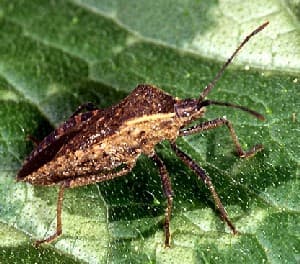How to Control Squash Bugs

Squash Bug Control
These pests are commonly found all over the United States. They feed on members of the Cucurbit family. This includes all kinds of squash, pumpkins, cucumbers, and watermelon. Among these, their favorite foods are yellow crookneck and yellow straight-neck squash, followed by pumpkins and Hubbard squash. Controlling squash bugs is very important when growing any members of the cucurbit family.
Squash bugs are very harmful to cucurbits. They suck the juices from the plants. They will also attack the fruit, If damage is significant, the vines turn black and die. And, they transmit plant diseases. Disease spores cling to their feet. Then plant diseases are spread, as the it flies from plant to plant.
Botanical Name: Anas Tristis
Identifying Squash Bugs
Adults are approximately 5/8″ long and 1/4″ wide. They are dark grey or black. There are orange and brown stripes on their abdomen. They are sometimes mistaken for stink bugs, which look similar. Like the stink bug, they also smell bad when crushed.
Note: Stink bugs do not bother cucurbits.
Squash Bug Eggs are yellowish-brown to red-bronze in color. The female deposits about a dozen eggs on the underside of plant leaves, along the veins of the leaves. Except for some southerly areas of the country, there is one brood a year.
Squash Bug Life Cycle
These insects live one year. In most areas, the adult female lays eggs once, in early summer. Eggs hatch quickly, and small nymphs begin to feed on plant juices.
Adult bugs will overwinter in brush and garden debris. They may be present in your compost pile.
How to Control Squash Bugs
Chemical sprays are most effective when applied just as the eggs are hatching.
Many people, including this author, hand-pick adults, and eggs from the plants. Adults are easy to catch. Eggs will be found on the underside of leaves. Once you spot adult squash bugs, examine the leaves every few days for eggs. Scrape off eggs with a knife, or your fingernail, and dispose of them.
An organic control is to place a flat board near the plant. Squash bugs will hide under boards and garden debris at night. In the early morning, lift up the board, and capture and dispose of any bugs you find.
Related Articles
Please support our site. Shop for:
- rmmatthews100@hotmail.com
- 585-721-6528
- Rochester, NY
©1999-2024 GardenersNet.Com, All Rights Reserved

